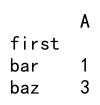Pandas loc
The pandas library in Python is a cornerstone for data manipulation and analysis. One of the most powerful features of pandas is the .loc attribute, which allows for label-based indexing. This guide will delve deep into the usage of pandas loc, providing a thorough understanding through examples and explanations.
Introduction to pandas loc
The .loc attribute is part of pandas DataFrame and Series objects. It is used to access a group of rows and columns by labels or a boolean array. .loc will raise a KeyError if the items are not found. Before diving into the examples, ensure you have pandas installed and imported:
import pandas as pd
Basic Usage of pandas loc
Example 1: Selecting a Single Row by Index Label
import pandas as pd
data = {'Name': ['Alice', 'Bob', 'Charlie'], 'Age': [25, 30, 35]}
df = pd.DataFrame(data, index=['pandasdataframe.com1', 'pandasdataframe.com2', 'pandasdataframe.com3'])
print(df.loc['pandasdataframe.com1'])
Output:

Example 2: Selecting Multiple Rows by Index Label
import pandas as pd
data = {'Name': ['Alice', 'Bob', 'Charlie'], 'Age': [25, 30, 35]}
df = pd.DataFrame(data, index=['pandasdataframe.com1', 'pandasdataframe.com2', 'pandasdataframe.com3'])
print(df.loc[['pandasdataframe.com1', 'pandasdataframe.com3']])
Output:

Example 3: Selecting Slices of Rows
import pandas as pd
data = {'Name': ['Alice', 'Bob', 'Charlie'], 'Age': [25, 30, 35]}
df = pd.DataFrame(data, index=['pandasdataframe.com1', 'pandasdataframe.com2', 'pandasdataframe.com3'])
print(df.loc['pandasdataframe.com1':'pandasdataframe.com3'])
Output:

Example 4: Selecting Columns with Rows
import pandas as pd
data = {'Name': ['Alice', 'Bob', 'Charlie'], 'Age': [25, 30, 35]}
df = pd.DataFrame(data, index=['pandasdataframe.com1', 'pandasdataframe.com2', 'pandasdataframe.com3'])
print(df.loc[:, 'Age'])
Output:

Example 5: Selecting Specific Rows and Columns
import pandas as pd
data = {'Name': ['Alice', 'Bob', 'Charlie'], 'Age': [25, 30, 35]}
df = pd.DataFrame(data, index=['pandasdataframe.com1', 'pandasdataframe.com2', 'pandasdataframe.com3'])
print(df.loc['pandasdataframe.com1', 'Age'])
Output:

Advanced Selection Using pandas loc
Example 6: Conditional Selection
import pandas as pd
data = {'Name': ['Alice', 'Bob', 'Charlie'], 'Age': [25, 30, 35]}
df = pd.DataFrame(data, index=['pandasdataframe.com1', 'pandasdataframe.com2', 'pandasdataframe.com3'])
print(df.loc[df['Age'] > 25])
Output:

Example 7: Modifying Data Using pandas loc
import pandas as pd
data = {'Name': ['Alice', 'Bob', 'Charlie'], 'Age': [25, 30, 35]}
df = pd.DataFrame(data, index=['pandasdataframe.com1', 'pandasdataframe.com2', 'pandasdataframe.com3'])
df.loc['pandasdataframe.com1', 'Age'] = 26
print(df)
Output:

Example 8: Adding a New Row
import pandas as pd
data = {'Name': ['Alice', 'Bob', 'Charlie'], 'Age': [25, 30, 35]}
df = pd.DataFrame(data, index=['pandasdataframe.com1', 'pandasdataframe.com2', 'pandasdataframe.com3'])
df.loc['pandasdataframe.com4'] = ['David', 40]
print(df)
Output:

Example 9: Using pandas loc with a Function
import pandas as pd
data = {'Name': ['Alice', 'Bob', 'Charlie'], 'Age': [25, 30, 35]}
df = pd.DataFrame(data, index=['pandasdataframe.com1', 'pandasdataframe.com2', 'pandasdataframe.com3'])
print(df.loc[lambda x: x['Name'] == 'Alice'])
Output:

Example 10: Using pandas loc with isin
import pandas as pd
data = {'Name': ['Alice', 'Bob', 'Charlie'], 'Age': [25, 30, 35]}
df = pd.DataFrame(data, index=['pandasdataframe.com1', 'pandasdataframe.com2', 'pandasdataframe.com3'])
print(df.loc[df['Name'].isin(['Alice', 'David'])])
Output:

Using pandas loc for MultiIndex DataFrames
Example 11: Creating and Selecting from MultiIndex DataFrame
import pandas as pd
data = {'Name': ['Alice', 'Bob', 'Charlie'], 'Age': [25, 30, 35]}
df = pd.DataFrame(data, index=['pandasdataframe.com1', 'pandasdataframe.com2', 'pandasdataframe.com3'])
tuples = list(zip(*[['bar', 'bar', 'baz', 'baz'],
['one', 'two', 'one', 'two']]))
index = pd.MultiIndex.from_tuples(tuples, names=['first', 'second'])
df_multi = pd.DataFrame({'A': [1, 2, 3, 4]}, index=index)
print(df_multi.loc['bar'])
Output:

Example 12: Selecting from Inner Level of MultiIndex
import pandas as pd
data = {'Name': ['Alice', 'Bob', 'Charlie'], 'Age': [25, 30, 35]}
df = pd.DataFrame(data, index=['pandasdataframe.com1', 'pandasdataframe.com2', 'pandasdataframe.com3'])
tuples = list(zip(*[['bar', 'bar', 'baz', 'baz'],
['one', 'two', 'one', 'two']]))
index = pd.MultiIndex.from_tuples(tuples, names=['first', 'second'])
df_multi = pd.DataFrame({'A': [1, 2, 3, 4]}, index=index)
print(df_multi.loc[('bar', 'two')])
Output:

Example 13: Cross-section Using xs
import pandas as pd
data = {'Name': ['Alice', 'Bob', 'Charlie'], 'Age': [25, 30, 35]}
df = pd.DataFrame(data, index=['pandasdataframe.com1', 'pandasdataframe.com2', 'pandasdataframe.com3'])
tuples = list(zip(*[['bar', 'bar', 'baz', 'baz'],
['one', 'two', 'one', 'two']]))
index = pd.MultiIndex.from_tuples(tuples, names=['first', 'second'])
df_multi = pd.DataFrame({'A': [1, 2, 3, 4]}, index=index)
print(df_multi.xs('one', level='second'))
Output:

Performance Tips Using pandas loc
Example 14: Using loc with Large DataFrames
import pandas as pd
data = {'Name': ['Alice', 'Bob', 'Charlie'], 'Age': [25, 30, 35]}
df = pd.DataFrame(data, index=['pandasdataframe.com1', 'pandasdataframe.com2', 'pandasdataframe.com3'])
large_data = pd.DataFrame({'A': range(1000000), 'B': range(1000000)})
print(large_data.loc[999999])
Output:

Example 15: Efficiently Modifying Large DataFrames
import pandas as pd
data = {'Name': ['Alice', 'Bob', 'Charlie'], 'Age': [25, 30, 35]}
df = pd.DataFrame(data, index=['pandasdataframe.com1', 'pandasdataframe.com2', 'pandasdataframe.com3'])
large_data = pd.DataFrame({'A': range(1000000), 'B': range(1000000)})
large_data.loc[500000:500010, 'A'] = 0
print(large_data.loc[500000:500010])
Output:

Common Mistakes and Errors
Example 16: KeyError When Using pandas loc
import pandas as pd
data = {'Name': ['Alice', 'Bob', 'Charlie'], 'Age': [25, 30, 35]}
df = pd.DataFrame(data, index=['pandasdataframe.com1', 'pandasdataframe.com2', 'pandasdataframe.com3'])
try:
print(df.loc['pandasdataframe.com5'])
except KeyError as e:
print(f"KeyError: {e}")
Output:

Example 17: Using pandas loc with Incorrect Column Name
import pandas as pd
data = {'Name': ['Alice', 'Bob', 'Charlie'], 'Age': [25, 30, 35]}
df = pd.DataFrame(data, index=['pandasdataframe.com1', 'pandasdataframe.com2', 'pandasdataframe.com3'])
try:
print(df.loc[:, 'Salary'])
except KeyError as e:
print(f"KeyError: {e}")
Output:

Pandas loc Conclusion
The pandas.loc attribute is an essential tool for data selection and manipulation in Python’s pandas library. Through the examples provided, we’ve explored its basic usage, advanced features, and common pitfalls. Mastery of pandas loc can significantly enhance your data handling capabilities in Python.
This guide has covered a wide range of scenarios, but remember that practice is key to mastering any new skill. Experiment with pandas loc in your projects and explore the pandas documentation to discover more complex use cases and optimizations.
 Pandas Dataframe
Pandas Dataframe